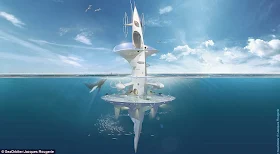This diagram
details the different features of the SeaOrbiter vessel. It has a platform lift
for divers on the left-hand side, while stern thrusters power the ship. Bunks
for the crew as well as the VIP cabin and Captain's room are on the right-hand
side. The retractable keel weighs 180 tonnes.
Αν
μας βλέπει από κάπου ο Ζακ Υβ Κουστό είναι βέβαιο ότι θα ζηλεύει πολύ…
Called SeaOrbiter,
the 1,000-tonne floating aquatic lab, pictured, was designed by French
architect Jacques Rougerie. Construction on the ship is due to start in May
2014. Almost two-thirds of the 170-ft tall vessel will sit underwater making it
possible to directly study ecosystems and fish levels.
Ανακοινώθηκε
ότι στις 31 Μαΐου του 2014 θα ξεκινήσει η κατασκευή ενός εκπληκτικού θαλάσσιου
ή καλύτερα υποθαλάσσιου εργαστηρίου που μοιάζει βγαλμένο από ταινία
επιστημονικής φαντασίας. Το SeaOrbiter θα αναζητήσει απαντήσεις στα μυστήρια
των ωκεανών.
Υποβρύχιο…
Διάστημα
The SeaOrbiter,
illustration pictured, will feature a fish-collection system for studies of the
pelagic ecosystem, plankton biodiversity, and fish stocks. The project costs
$52.7 million and has support from Nasa and the European Space Agency because
the conditions on the SeaOrbiter are similar to those found in space.
Το
SeaOrbiter είναι μια εγκατάσταση ύψους 55 μέτρων. Το ένα τρίτο της εγκατάστασης
θα επιπλέει στο νερό ενώ τα δύο τρίτα θα βρίσκονται κάτω από την επιφάνειά του.
This computer
generated image shows what the SeaOrbiter will look like underwater. The
French-designed ship will be able to explore depths of around 6,000 metres.
Between 18 and 22 marine biologists will live on board at any one time because
it has living quarters and kitchens.
Το
θαλάσσιο εργαστήριο σχεδίασε ο γάλλος αρχιτέκτονας Ζακ Ρουζερί και το κόστος
της κατασκευής ανέλαβαν από κοινού η NASA και ο Ευρωπαϊκός Οργανισμός
Διαστήματος (ESA).
This is how the
SeaOrbiter is expected to look from the ocean floor. The laboratory part of the
ship, pictured, will sit below the surface to make the SeaOrbiter buoyant, but
to also give a direct line of sight and access into the ocean.
Οι
δύο υπηρεσίες αποφάσισαν να συγχρηματοδοτήσουν το SeaOrbiter επειδή τόσο το
ίδιο το εργαστήριο όσο και οι συνθήκες στις οποίες θα λειτουργεί προσομοιάζουν
με εκείνες του Διαστήματος - αποτελεί έτσι ένα σημαντικό και σχετικά προσιτό
οικονομικώς «πείραμα».
The SeaOrbiter
vessel, pictured, will be powered by wind, wave and solar energy. Although the
SeaOrbiter has been designed to drift with ocean currents, the European Defense
and Space systems (EADS) is also said to be developing a biofuel that could be
used as a secondary power source.
Το
κόστος του SeaOrbiter αναμένεται να αγγίξει τα 53 εκ. δολάρια. Θα λειτουργεί με
φιλικές στο περιβάλλον, ανανεώσιμες πηγές ενέργειες (αιολική, ηλιακή κ.α.).
Στο
εργαστήριο θα μπορούν να ζουν και να εργάζονται 18-22 επιστήμονες και
αναμένεται να αποτελέσει «παράδεισο» για τους ωκεανολόγους και τους θαλάσσιους
βιολόγους.






Δεν υπάρχουν σχόλια:
Δημοσίευση σχολίου